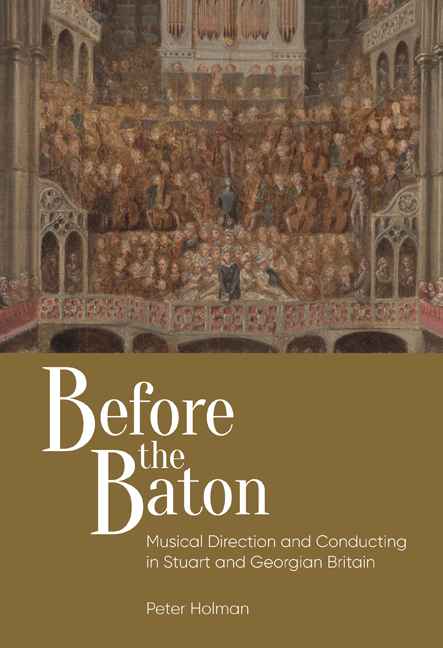Book contents
- Frontmatter
- Dedication
- Contents
- List of Illustrations
- Foreword
- Acknowledgements
- Note to the Reader
- List of Abbreviations
- Prelude To Beat or Not to Beat: The Continental Context
- Part I Directing Choral Music
- Chapter 1 ‘Heard but not Seen’: Leading Anglican Cathedral Music from the Organ
- Chapter 2 ‘With a Scroll of Parchment or Paper, in Hand’: Large- Scale Choral Music
- Chapter 3 ‘Accompanied all along on the Organ by his Own Inimitable Hand’: Handel and the Direction of his Oratorios
- Chapter 4 ‘The Conductor at the Organ’: The Oratorio Tradition after Handel
- Part II Directing Opera and Theatre Music
- Chapter 5 ‘That Ridiculous Custom’: From Devolved Direction to Centralized Time-Beating in Seventeenth-Century Theatre Music
- Chapter 6 ‘Il maestro al cembalo’: Directing Opera and Theatre Music from the Harpsichord
- Chapter 7 ‘A New Discipline and a New Style of Playing’: Directing Opera and Theatre Music from the Violin
- Chapter 8 ‘That Powerful Sovereign, the Conductor’: From the Piano to the Rostrum
- Postlude Superconductors or Semiconductors? Lessons for Today
- Bibliography
- Index
- Miscellaneous Endmatter
Chapter 6 - ‘Il maestro al cembalo’: Directing Opera and Theatre Music from the Harpsichord
Published online by Cambridge University Press: 11 September 2020
- Frontmatter
- Dedication
- Contents
- List of Illustrations
- Foreword
- Acknowledgements
- Note to the Reader
- List of Abbreviations
- Prelude To Beat or Not to Beat: The Continental Context
- Part I Directing Choral Music
- Chapter 1 ‘Heard but not Seen’: Leading Anglican Cathedral Music from the Organ
- Chapter 2 ‘With a Scroll of Parchment or Paper, in Hand’: Large- Scale Choral Music
- Chapter 3 ‘Accompanied all along on the Organ by his Own Inimitable Hand’: Handel and the Direction of his Oratorios
- Chapter 4 ‘The Conductor at the Organ’: The Oratorio Tradition after Handel
- Part II Directing Opera and Theatre Music
- Chapter 5 ‘That Ridiculous Custom’: From Devolved Direction to Centralized Time-Beating in Seventeenth-Century Theatre Music
- Chapter 6 ‘Il maestro al cembalo’: Directing Opera and Theatre Music from the Harpsichord
- Chapter 7 ‘A New Discipline and a New Style of Playing’: Directing Opera and Theatre Music from the Violin
- Chapter 8 ‘That Powerful Sovereign, the Conductor’: From the Piano to the Rostrum
- Postlude Superconductors or Semiconductors? Lessons for Today
- Bibliography
- Index
- Miscellaneous Endmatter
Summary
❧ Italian Opera in London 1705–1717
THE process of establishing Italian opera in London began with the construction of a new theatre, John Vanbrugh's Queen's (later King’s) Theatre in the Haymarket. It opened on 9 April 1705 with the first Italian opera produced in England, Gli amori d’Ergasto by the German composer Jakob Greber. However, it proved to be a flash in the pan: the company that put it on soon went home or dispersed, and for the next few years there was a complex and rapid series of changes in London's theatrical scene. Opera lovers had to be content with Italianate English operas or pasticcios based on older Italian works, bilingual or entirely in English. They were mostly put on at Drury Lane; the Haymarket Theatre only became the permanent home of Italian opera in January 1708, a status it (and the building that succeeded it) was to retain with a few interruptions until 1847. London's first Italian opera company was never profitable, but it managed to stagger on until it collapsed in 1717. Much more is known about its activities than most Italian opera companies of the time because of the Coke papers. Thomas Coke, the Vice-Chamberlain, was the official in day-to-day charge of theatrical affairs in London from 1706 until his death in 1727. The two patent theatres had been under royal patronage from soon after the Restoration, so their employees were technically courtiers under the jurisdiction of the Lord Chamberlain, the head of the royal household.
The Coke papers tell us much about how the first Haymarket company was set up and directed. A list dated 1 December 1707 of 14 instrumentalists given leave ‘to perform in the Operas at the Queens Theatre in the Haymarkett’, shows that Vanbrugh's attempts to secure an operatic monopoly involved poaching them from Christopher Rich at Drury Lane. This is confirmed by a petition of 31 December 1707 from the French composer and harpsichordist Charles Dieupart to Coke, complaining of Rich's treatment of the Drury Lane performers.
- Type
- Chapter
- Information
- Before the BatonMusical Direction and Conducting in Stuart and Georgian Britain, pp. 215 - 252Publisher: Boydell & BrewerPrint publication year: 2020



